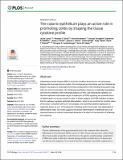The colonic epithelium plays an active role in promoting colitis by shaping the tissue cytokine profile
Author(s)
Ghazi, Phaedra C.; Tovaglieri, Alessio; Baldwin, Katherine R.; Poulin, Emily J.; Gierut, Jessica J.; Genetti, Casie; Yajnik, Vijay; Breault, David T.; Haigis, Kevin M.; Lyons, Jesse Stolberg; Starchenko, Alina; Lauffenburger, Douglas A; ... Show more Show less
Downloadjournal.pbio.2002417.pdf (14.48Mb)
PUBLISHER_CC
Publisher with Creative Commons License
Creative Commons Attribution
Terms of use
Metadata
Show full item recordAbstract
Inflammatory bowel disease (IBD) is a chronic condition driven by loss of homeostasis between the mucosal immune system, the commensal gut microbiota, and the intestinal epithelium. Our goal is to understand how these components of the intestinal ecosystem cooperate to control homeostasis. By combining quantitative measures of epithelial hyperplasia and immune infiltration with multivariate analysis of inter- and intracellular signaling, we identified epithelial mammalian target of rapamycin (mTOR) signaling as a potential driver of inflammation in a mouse model of colitis. A kinetic analysis of mTOR inhibition revealed that the pathway regulates epithelial differentiation, which in turn controls the cytokine milieu of the colon. Consistent with our in vivo analysis, we found that cytokine expression of organoids grown ex vivo, in the absence of bacteria and immune cells, was dependent on differentiation state. Our study suggests that proper differentiation of epithelial cells is an important feature of colonic homeostasis because of its effect on the secretion of inflammatory cytokines.
Date issued
2018-03Department
Massachusetts Institute of Technology. Department of Biological EngineeringJournal
PLOS Biology
Publisher
Public Library of Science
Citation
Lyons, Jesse et al. “The Colonic Epithelium Plays an Active Role in Promoting Colitis by Shaping the Tissue Cytokine Profile.” Edited by Ken Cadwell. PLOS Biology 16, 3 (March 2018): e2002417 © 2018 Lyons et al
Version: Final published version
ISSN
1545-7885
1544-9173